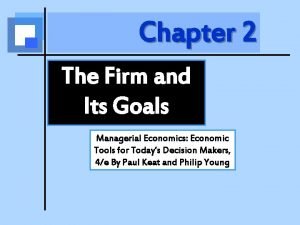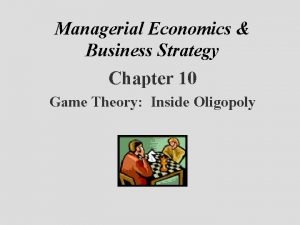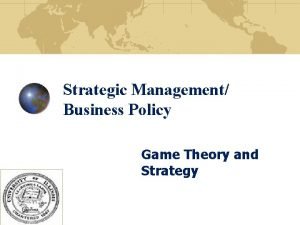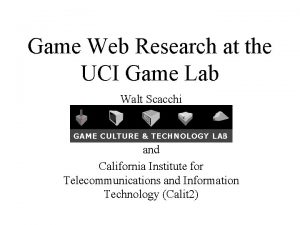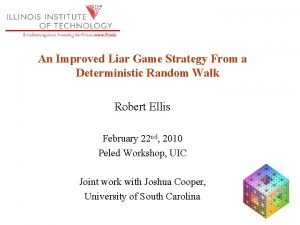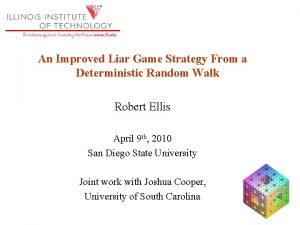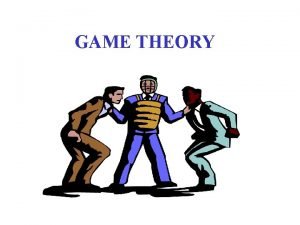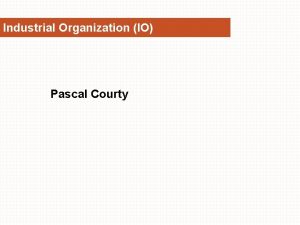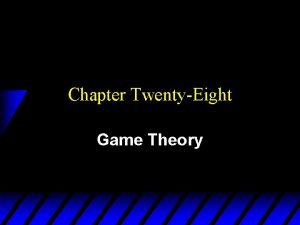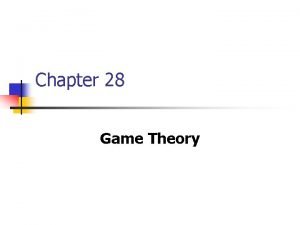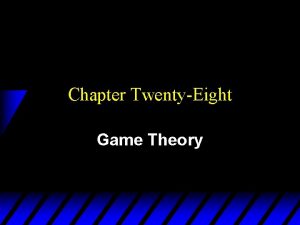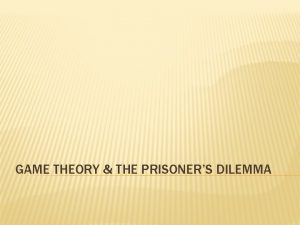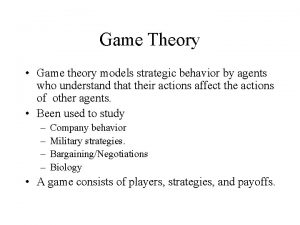GAME THEORY AND INDUSTRIAL ECONOMICS ORGANIZATION FIRMS STRATEGIC











- Slides: 11

GAME THEORY AND INDUSTRIAL ECONOMICS (ORGANIZATION) • FIRMS’ STRATEGIC BEHAVIOUR • Strategic interaction among economic agents (a sort of externality: the action of firm A affects the profits of firm B) • OLIGOPOLY: it is not (necessarily) characterised by the presence of a few – large – firms but it emerges when there is interdependence among them “Except where monopoly is assumed and the possibility of entry is assumed away, theoretical research in industrial economics today employs the tools of non-cooperative game theory. […] It is then assumed that the observed behaviour will correspond to a Nash equilibrium of the specified game, a situation in which each firm’s strategy (…) is a best response to the strategies of its rivals”. (R. Schmalensee, Industrial economics: an overview, Economic Journal, 1988, p. 645) 1

NON-COOPERATIVE GAMES: NASH EQUILIBRIUM • John Nash (1950) proved the existence of an equilibrium point in non-cooperative games • Nash theorem: every game with a finite number of players and strategies has, at least, one equilibrium (in pure or mixed strategies) • Each player chooses the “best-response” strategy (that maximising her payoff) to other players’ strategies. So, intuitively, if every one is making the best response to everyone else, no player will change her strategy • Problem: multiple Nash equilibria 2

NASH EQUILIBRIUM IN OLIGOPOLY • In oligopoly, the Nash equilibrium coincides with that of: – Cournot, when the strategies are based on output quantities (Cournot-Nash equilibrium): LONG-RUN CHOICE – Bertrand, when the strategies are based on prices (Bertrand-Nash equilibrium): SHORT-RUN CHOICE 3

Duopoly models • Πi(ai, aj) profit function twice continuously differentiable in the actions; ai, j= actions of firms i and j (price or quantity) • A pair of feasible actions is a Nash equilibrium if Πi(a*i, a*j) ≥ Πi(ai, a*j) • F. O. C. Πii(ai, aj)=0 (where Πii = ∂Πi/∂ai) • From this we get the reaction functions (best response functions) of the two firms: Ri(aj) is the best response of firm i when firm j chooses aj • Nash equilibrium (solve the system of two equations with two unknowns): a*i=Ri(a*j) and 4 a*j=Rj(a*i)

COURNOT MODEL • Original duopoly model by Antoine Augustin Cournot (1838): Researches into the mathematical principles of theory of wealth (Chapter VII “Of the competition of producers”). • Two “proprietors” of water springs with identical quality and zero production costs. Hypotheses: product homogeneity; zero production costs = equal and constant marginal costs. • Each producer is aware that the rival's quantity decision will also affect the price he faces and thus his profits. Consequently, each producer chooses a quantity that maximizes his profits subject to the quantity chosen by the rival. 5

• The above is the concept of “reaction function”. The symmetric equilibrium quantities can be drawn as the intersection of the reaction curves of the two producers. Given the quantities, one can get the equilibrium price and, then, the symmetric producers’ profits • Comparing solutions, Cournot notes that under duopoly, the price is lower and the output greater than under monopoly. In the subsequent chapter, he shows that as the number of producers increases, the output becomes greater and the price lower • This is the Cournot paradigm for antitrust policy (which, however, holds only in presence of constant returns to scale) 6

COURNOT MODEL: A REVIEW OF HISTORY OF ECONOMIC THOUGHT • Robert J. Leonard (1994) Reading Cournot, Reading Nash: The Creation and Stabilisation of the Nash Equilibrium, Economic Journal, Vol. 104, pp. 492 -511. • Dynamic representation of the Cournot model as a sequence of actions and reactions that lead to the equilibrium point • Fellner (1949): inconsistency of the model. To assume the rival’s quantity as fixed does make sense only if we are already at the equilibrium point • A truly rational firm knows that the rival will use a reaction function; then, he will take the rival’s reaction function as given and, consistently, choose the quantity that maximises his profit • But even the other firm will do the same and, then, there will be no unique equilibrium (multiple equilibra) 7

• Note: to assume as given the rival’s reaction function is the hypothesis of the Stackelberg’s model (1934) which produces an equilibrium only if represented as a sequential game with perfect information • Only after the appearance of the Nash equilibrium (1950) Cournot model is “re-read” through a new lens: that of a one-shot non-cooperative game with simultaneous choices • This was the Shubik’s interpretation (1952): Cournot model from being dynamic and inconsistent becomes static and consistent • This also served to legitimate the Nash equilibrium among economists: Cournot model was taken as the historical foundation of the Nash equilibrium 8

BERTRAND MODEL • In 1883 Joseph Bertrand published a review of the Cournot’s book (which, up to then, had been neglected by economists). He radically criticised the Cournot duopoly model for being based on the choice of quantities rather than prices • If the product is homogenous and two firms with identical linear cost functions choose prices, the price competition will led to a perfectly competitive equilibrium= price equal to marginal cost and zero profits • This is the well known Bertrand paradox, which can be “solved” in many ways (see below) 9

PRICE GAME WITH HOMOGENEOUS PRODUCTS (BETRAND GAME) ΠM = monopoly profits Firm 2 High price (collusion) Firm 1 High price (collusion) Low price (undercutting) ΠM/2 ΠM- ΠM/2 Low price (undercutting) ΠM- 0 0 Nash equilibrium = Low-Low = zero profits 10

AVOIDING BERTRAND PARADOX • Capacity constraint. Originally introduced by Edgeworth (1897). Reprised by Kreps and Scheinkman (1983) Quantity pre-commitment and Bertrand competition yeld Cournot outcomes, BJo. E (two-stage game: in the first stage firms choose productive capacity and in the second compete in prices). • Product differentiation. Hotelling model (1929) of horizontal differentiation revisited by d’Aspremont, Gabszewicz and Thisse (1979) On Hotelling’s stability in competition, Econometrica [two-stage game: in the first firms choose the location in the space of characteristics and in the second compete in prices]. Vertical differentiation model of Shaked and Sutton (1982) Relaxing price competition through product differentiation REc&St [three-stage game]. • Repeated game. Under given conditions the collusion is an equilibrium (Folk Theorem) and the two firms gain half of the 11 monopoly profit.
 Goals of the firm
Goals of the firm Game theory managerial economics
Game theory managerial economics Game theory in strategic management
Game theory in strategic management Pirate game theory
Pirate game theory Game lab game theory
Game lab game theory Liar game game theory
Liar game game theory Liar game game theory
Liar game game theory Game theory and graph theory
Game theory and graph theory School of business and economics maastricht
School of business and economics maastricht Strategic complement
Strategic complement Resource based model
Resource based model Strategy analysis and choice largely involves making
Strategy analysis and choice largely involves making
